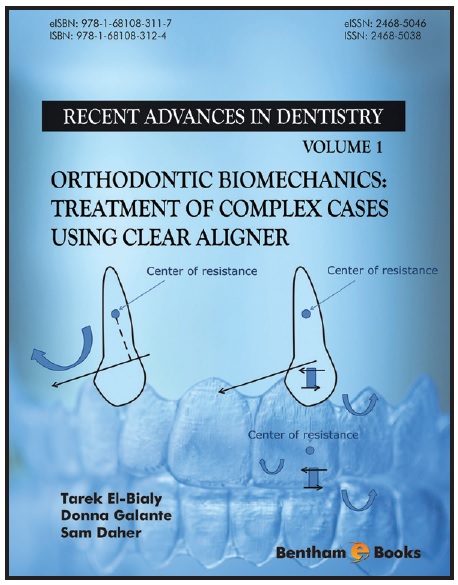BOOK REVIEW
Orthodontic Biomechanics: Treatment of Complex Cases Using Clear Aligner
TAREK EL-BIALY
DONNA GALANTE
SAM DAHER
138 pages. $59 for eBook, $70 for print-on-demand, $99 for both versions. 2016.
Bentham Science (DMedia Associates, Inc., in North America), 11700 Le Havre Drive, Potomac, MD 20854. (301)
340-1987; www.benthamscience.com.
As stated in the introduction to this book, "It can be inferred that there is so much to learn regarding the biomechanics and efficacy of the Invisalign or similar clear aligner systems." With that in mind, Dr. Tarek El-Bialy smartly lays the foundation for a clinician's commitment to truly understanding how best to move teeth without using fixed appliances. To help in this endeavor, two of the most well-known and respected clinicians in aligner therapy, Drs. Donna Galante and Sam Daher, have been enlisted as co-authors. The resulting blend of academics meets real-world private practice is what makes this contribution to our literature so impactful.
After assessing aligners' unique effects on the basic science and physiology of orthodontic tooth movement, the authors supply the usual review of a thorough and proper diagnosis - but with an angle favoring conebeam computed tomography and computer-aided design and manufacturing technologies. The book then dives directly into what makes it truly distinctive: a fundamental application of fixed-appliance biomechanics to aligner therapy, incorporating the unique features that aligners embody. Such merits are based on the concepts that digital planning provides the most direct path from initiation to completion of treatment; that the removable nature of aligners provides optimal hygiene without dietary restrictions, as is the challenge with fixed appliances; and that occlusal coverage is advantageous in deep bites, open bites, and crossbites, and to disarticulate the dentition for sagittal correction in Class II and Class III cases.
Similar articles from the archive:

The chapter on biomechanics methodically breaks down the components of specific tooth movements (tipping, translation, rotations, and torquing) and then builds them back up into methods of planning for these movements with aligners. Elegant illustrations are combined with both radiographic images and ClinCheck still shots to drive home the essential principles of how plastic interacts with attachments and tooth surfaces to create the forces necessary for eliciting desired movements as they relate to the center of resistance. Seven chapters, each detailing specific mechanics, are dedicated to case types. The records are of high quality, and the captions allow the reader to easily follow treatment progress from start to completion. Whether you are newly committed to incorporating aligner therapy into your armamentarium or are a seasoned clinician adept at using aligners in more complex cases, this textbook is a must-have for your library. You will not be disappointed.
JONATHAN NICOZISIS, DMD, MS

